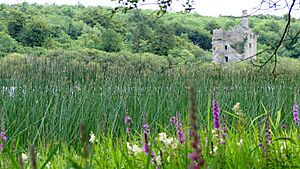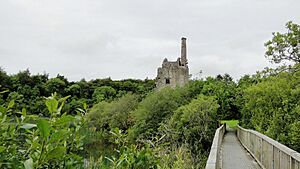Dromore, County Clare facts for kids
Quick facts for kids Dromore Wood |
|
|---|---|
| Dromore, County Clare | |

Woodland path in Dromore Wood
|
|
| Lua error in Module:Location_map at line 420: attempt to index field 'wikibase' (a nil value). | |
| Nearest city | Ennis |
| Area | circa 1,000 acres |
| Established | 1985 |
| Governing body | National Parks and Wildlife Service (Ireland) |
Dromore, County Clare, is a beautiful rural area in County Clare, Republic of Ireland. It's part of the Ruan parish. This area is mostly known for the amazing Dromore Wood Nature Reserve. It's a fantastic place to visit and explore nature. You can also find the old ruins of Dromore Castle here.
Contents
Exploring Dromore Wood
Dromore Wood is located between the towns of Crusheen and Corofin. It's west of the M18 motorway and north of Ennis. The area is home to Dromore Lake, which is fed by the River Fergus.
This nature reserve has many different types of landscapes. You can find:
- Rivers and lakes
- Turloughs (special lakes that disappear and reappear)
- Callows (meadows that often flood)
- Cool limestone pavement (flat rock areas)
- Fens (wetlands)
- Reed beds (areas with tall grasses)
- Beautiful woodlands
A Glimpse into History
Dromore Wood has a rich history, especially around Dromore Castle. This castle was likely built in the early 1500s. In the 1600s, a man named Teige O'Brien from the powerful O'Brien family made repairs and added to the castle. His family had owned the castle and lands since 1579.
Teige's son, Dermot, was involved in some important conflicts during the 1600s. The last O'Brien to live in the castle left in 1689. After that, the castle slowly fell into ruin over the 1700s.
Later, in the 1800s, a family called the Crowes lived in Dromore House nearby. This house was originally a hunting lodge. It became their main home in the 1830s.
In the 1930s, Dromore House was sold and later taken down. The Irish government bought Dromore Wood in the 1940s. For a while, it was used as a forest for cutting down trees. But in the 1980s, the National Parks and Wildlife Service (Ireland) took over. In 1985, Dromore Wood officially became a protected nature reserve.
You can also find other historical spots nearby. These include the ruins of Cahermacrea Castle, parts of Kilbakee Church, and old ring forts. There's even an old limekiln and a chapel.
Amazing Animals and Plants
Dromore Wood is a fantastic place for wildlife! Many interesting animals call this area home.
- Mammals: Look out for the shy pine marten, red squirrels, badgers, stoats, foxes, hares, shrews, wood mice, and eight different kinds of bats. Otters also live here.
- Birds: You might see coots, grebes, moorhen, water rail, and herons. In winter, when the area floods, many visiting birds arrive. These include teal, wigeon, goldeneye, tufted duck, pochard, shoveler, and beautiful whooper swans. A rare white-tailed eagle was even seen here in 2011 and 2012!
- Insects: The reserve is also home to many dragonflies and different types of butterflies.
Visiting Dromore Wood Today
The Dromore Wood Nature Reserve covers about 1,000 acres (400 hectares). A larger area around it is also protected as a Special Area of Conservation. This means it's very important for nature.
The visitor centre at Dromore Wood is managed by the National Parks & Wildlife Service. It's connected to the Coole Park Nature Reserve near Gort. Dromore Wood Nature Reserve has six marked walking trails. They are all different lengths, so you can choose the best one for your adventure!



